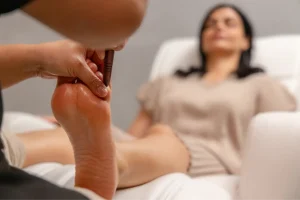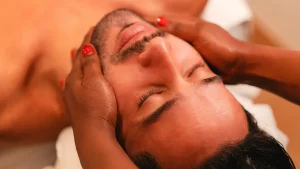The world between departure and destination
There is a strange moment that belongs only to air travel. The hum of the engines turns into a heartbeat, the cabin lights dim, and the earth falls away. For a few suspended hours, you live between worlds, untethered from geography and routine. Most travelers endure this space. The Be Relax traveler learns to inhabit it.
Airports are cathedrals of motion. They are bright, loud, and impatient, designed for movement rather than comfort. Yet hidden in their rhythm lies a chance to reclaim something sacred: calm. Be Relax was created for that exact moment, when the world rushes and you choose stillness instead.
For almost two decades, Be Relax has been that pocket of peace within terminals across the globe. A sanctuary of low light, quiet music, and expert touch that brings the body back to itself. Behind every massage, mist, and breathing space lies science translated into care. Be Relax does not romanticize rest. It studies it.

The body under pressure
At cruising altitude, the human body is asked to do something unnatural. The cabin air is recirculated, pressurized, and stripped of moisture. Humidity often drops below 20 percent, sometimes closer to 10, which is drier than most deserts. Studies published in aviation medicine journals have shown that this extreme dryness can lead to measurable fluid loss, skin dehydration, and mucosal irritation. Over long-haul flights, a traveler can lose up to a liter and a half of water without ever feeling thirsty.
Dehydration is more than discomfort. Research from the University of Connecticut found that even a two percent reduction in body water led to a measurable decline in attention, alertness, and short-term memory. Participants also reported increased fatigue and irritability. The study concluded that hydration is directly linked to both physical performance and mood regulation.

Circulation, stillness, and the weight of altitude
Airplanes are designed for efficiency, not anatomy. Sitting for ten or more hours in a pressurized cabin changes how blood moves through the body. Gravity pulls blood toward the legs, slowing its return to the heart. In mild cases, this causes swelling and heaviness. In prolonged stillness, it increases the risk of clot formation, a condition doctors call deep vein thrombosis.
A study in the British Journal of Surgery found that travelers who wore graduated compression socks had significantly less swelling and discomfort during long flights. The pressure gradient helps the veins push blood upward, reducing fatigue and improving oxygen delivery. What appears to be a small detail in packing is, in reality, a safeguard for circulation and comfort.
Be Relax recommends compression socks as part of every traveler’s ritual. They are not an accessory but an instrument of self-care. Alongside this, even simple movements such as ankle rotations or calf raises every hour help maintain healthy flow. The goal is not perfection but motion, small gestures that protect the body from the physics of flight.

The rhythm that rules us
Every cell in the body carries a clock. This internal rhythm, known as the circadian cycle, governs when we feel hungry, sleepy, alert, or calm. It is influenced by light, food, and social cues. Crossing time zones scrambles this delicate rhythm, producing what we call jet lag. Science describes it as circadian desynchrony, the body’s confusion about when to rest and when to rise.
Chronobiologists at Harvard have demonstrated that adjusting eating times can reset the peripheral body clocks found in organs like the liver, and can help mitigate jet lag and shift work. Eating breakfast according to the local time of your destination, even if your body insists it is the middle of the night, can accelerate adjustment. In contrast, skipping meals or eating erratically amplifies the internal confusion.
Be Relax encourages travelers to eat with intention. Light meals rich in protein and fiber support digestion and maintain stable blood sugar levels. Studies published in the American Journal of Clinical Nutrition found that high glycemic foods, such as refined carbohydrates and sugary snacks, increased fatigue and reduced alertness during long travel periods. By aligning meals with destination time and choosing nutrient-dense options, travelers can restore both rhythm and mood before they even land.

Mood in motion
Flying is a test of psychology as much as physiology. The noise, the confinement, the disrupted sleep cycle — all are triggers for stress hormones. NASA’s Human Factors Laboratory has recorded elevated cortisol levels and reduced serotonin synthesis during prolonged flights. The cabin’s low oxygen and humidity intensify this imbalance, leading to agitation, restlessness, and post-landing exhaustion.
Be Relax responds to this with touch. Massage therapy, often dismissed as indulgence, has proven neurological benefits. Meta-analyses across multiple populations show that massage reduces cortisol levels by as much as 30 percent while increasing serotonin and dopamine, the neurotransmitters responsible for mood regulation. Even brief sessions of fifteen minutes can lower heart rate and blood pressure, producing a measurable state of calm.
In a Be Relax spa, this science becomes a sensory experience. The traveler steps out of the airport’s mechanical rhythm into a space where movement slows. A therapist’s hands find the knots left by deadlines and time zones. Shoulders drop. Breathing deepens. The nervous system resets. What follows is physiological repair.

The quiet science of skin
Cabin environments are notoriously harsh on skin health. Low humidity and recycled air strip the stratum corneum of its protective oils. Dermatology research from the University of Hamburg found that after just eight hours in a low-humidity environment, skin hydration dropped by nearly 30 percent. This reduction weakens the barrier function and can cause inflammation, tightness, or premature dullness.
Be Relax’s facials were designed for these exact conditions. The application itself is therapeutic. Gentle self-massage of the face stimulates lymphatic flow, relieving puffiness while triggering the parasympathetic nervous system. This is biology used beautifully.

Light, darkness, and the recalibration of self
Light remains the strongest synchronizer of the body’s clock. Exposure to bright light at the right time can shift circadian rhythm faster than any supplement. Researchers from Stanford recommend seeking morning sunlight upon arrival to help the body adjust to new time zones. Conversely, limiting light exposure in the hours before local bedtime helps melatonin production and supports sleep onset.

The psychology of arrival
Arrival is often treated as the end of travel, but physiologically it is a beginning. The hours after landing are when the body decides how long recovery will take. A study from Stanford University found that travelers who practiced brief grounding exercises before and after flight, such as slow breathing, aromatherapy, or mindfulness, adapted to new time zones nearly twice as fast as those who did not.
Be Relax’s philosophy aligns perfectly with this science. The spaces are not just for pre-flight indulgence but for post-flight recalibration. A twenty-minute massage or a few moments of guided relaxation between connections signals to the nervous system that the journey is easing. Cortisol drops, endorphins rise, and the mind reconnects to the body. The transition from motion to rest becomes gentle, not jarring.

Wellness as the new status
In the golden age of aviation, luxury was defined by exclusivity: the fastest boarding lane, the most private lounge, the heaviest glass of champagne. Today, true luxury is recovery. It is the ability to step off a twelve-hour flight feeling whole. Be Relax has quietly rewritten what status in travel means. Wellness is no longer a postscript. It is the signature of modern movement.
Every product, every service, every scent in Be Relax’s world serves a single purpose, to give travelers back the time that motion tries to steal. Massage before takeoff. Calm in flight. Hydration upon arrival. It is a philosophy: to travel without losing yourself along the way.
Conclusion: The science of stillness
Science has always been the study of connection, between cause and effect, stimulus and response, body and mind. Be Relax translates that science into sanctuary. It turns physiology into feeling, and wellness into art.
The journey does not have to drain you. It can restore you.
You can leave one world, cross the sky, and arrive not depleted but renewed.
That is the quiet promise Be Relax keeps serenity at 35,000 feet, and the simple grace of feeling human again.





